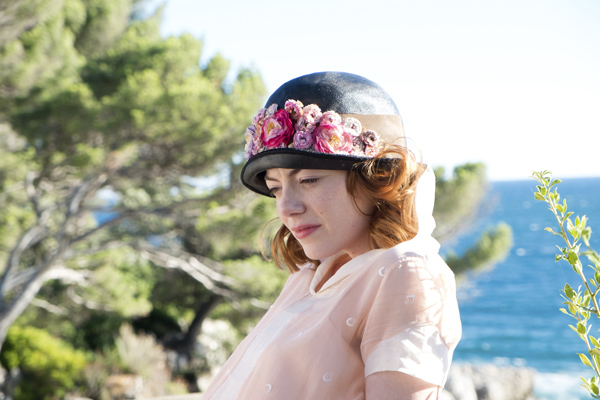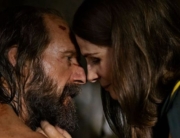The title of Woody Allen’s new comedy sounds like it was lifted from a swooning Tin Pan Alley ditty from the 1920s, which is fitting, since that era’s songbook is the film’s not-so secret elixir. Viewers are more likely to leave humming the songs rather than remembering the dialogue or even the film itself. The potency of this confection is ephemeral.
Allen returns to 1920s France after venturing there in his popular Midnight in Paris, this time to the Riviera. Stanley Crawford (Colin Firth), a top-billed magician—under the name Wei Ling Soo, in full Fu Manchu drag—accepts the invitation of his longtime friend and rival magician Howard Burkan the Great (Simon McBurney) to travel to the South of France to expose as a fraud Sophie Baker (Emma Stone). A medium from Kalamazoo, Michigan, she has become “the talk of the Côte d’Azur,” and Howard believes she’s fleecing a rich Pittsburgh family.
The family’s heir, Brice Catledge (Hamish Linklater), has fallen in love with Sophie as she stays at the family’s coastal estate. After dinner, she communicates with the dead for no money, just a donation for her foundation of the study of the paranormal. Sure enough, Brice serenades her, crooning to his ukulele and providing opportunities for other 1920s hits to be heard. This script, not Bullets Over Broadway, is more a natural for the Great White Way than that precisely structured, jauntily paced valentine to 1920s Manhattan and the theatah. Songs would interrupt its rhythm. (The musical version opened this spring to very mixed reviews and soon will close.)
A trip to the Mediterranean offers Stanley a chance to visit his grande dame Aunt Vanessa (Eileen Atkins) and for an ego boost in the debunking of the American. He knows the tricks of the trade, though Howard is concerned that the sarcastic and aloof Stanley will not quite fit in with the swells, since he has, as Stanley puts it, the “charm of a typhoid epidemic.” His words will ring true.
Sophie is practically a fully formed character before she strides onto the screen, thanks to the buildup in the exposition. She’s like a homespun Madame Acarti from Noël Coward’s Blithe Spirit, though there’s nothing daffy about this no-nonsense Midwestern clairvoyant who has taken her talents on the road, with a nudge from her stage mother (the underused Marcia Gay Harden). Flummoxed by her know-how, even Stanley has to admit she’s convincing, and Sophie’s onto him as well, knowing he’s her toughest audience yet.
Given the milieu, the rather flimsy plot has the bone structure of a drawing room comedy from the Roaring Twenties and the early 1930s. The film is not merely theatrical for its obviously fake night sky backdrop. More so than usual, Allen directs his players to face out to the camera, with Firth standing at the lip of center stage. Indeed, the script feels a little dusty, as though it has been sitting in the desk drawer for a while, ready for an out-of-town tryout but not yet Broadway bound. If you ponder the motivations of any of the characters too long, the smoke and mirrors will be apparent.
Many plays from that time set in a gilded bubble have a sting: S. N. Behrman’s The Second Man, Edna Ferber and George S. Kaufman’s Dinner at Eight. In Moonlight, there are no dark clouds on the horizon, only temporary showers. The banter comes across as a conversation over nightcaps, not too spirited to spoil the buzz at such a late hour.
Moreover, the film’s period perfect look doesn’t make up for its lack of style. The pace of the dialogue saunters when it should zip. Watch any of the movie adaptations of Philip Barry’s plays—The Animal Kingdom, Holiday, The Philadelphia Story—and you’ll see that it’s the cast, not the editing or the storyline, that moves the film along at a breakneck speed, delivering the most banal plot points with pizzazz and flair, lest the audience’s attention wanders. Where the energy should fizz, it falls flat.
Both Stone and Firth need to be goosed or at least given a kick in the pants to enliven their rather routine flirtation when, and this shouldn’t be a surprise, Stanley and Sophie develop feelings for each other. These are controlled and contemporary performances. It’s not only the on-location scenery that might steal the audience’s focus. Dialogue delivered at a clipped pace would have given the audience less time to think, and there are plenty of opportunities to do so during the deadly fumbling pauses between lines. Any introspection pops this bubble of a story. The characters stand solidly on the ground. They’re wallflowers compared to the outsized, lust for living archetypes from Bullet, any one of whom would have easily become the life of this party.
Firth especially feels constrained. Often he’s directed to enter a room and sit down, and he stays planted. He frequently resorts to one posture: slightly slouched, hands in pockets, more dejected than debonair. Not since Allen’s You Will Meet a Tall Dark Stranger has his cast been left so aimlessly to their own devices, at a loss for to what to do. At least Atkins has a game of cards to keep her occupied in an important moments with Firth, one of the few times when someone is fully committed to what they are saying or doing. She is so concentrated on a round of solitaire that the audience will forget about the lovelorn Firth and wonder whether or not she has a winning hand.







Leave A Comment